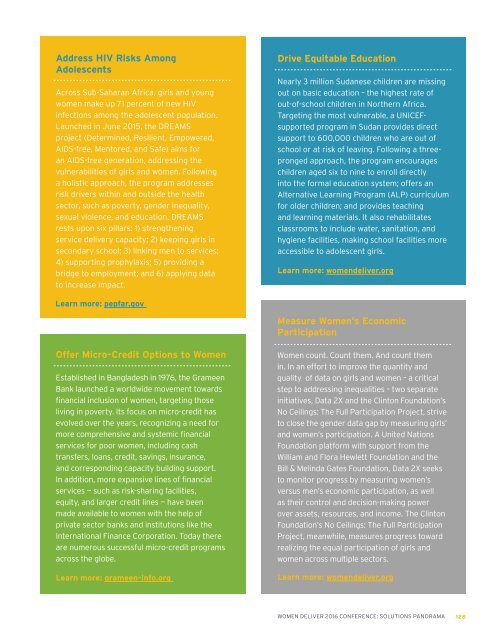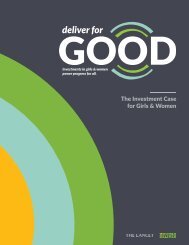Solutions Panorama
A collection of 100 programs, initiatives, and strategies that were shared at the Women Deliver 2016 Conference.
A collection of 100 programs, initiatives, and strategies that were shared at the Women Deliver 2016 Conference.
You also want an ePaper? Increase the reach of your titles
YUMPU automatically turns print PDFs into web optimized ePapers that Google loves.
Address HIV Risks Among<br />
Adolescents<br />
Across Sub-Saharan Africa, girls and young<br />
women make up 71 percent of new HIV<br />
infections among the adolescent population.<br />
Launched in June 2015, the DREAMS<br />
project (Determined, Resilient, Empowered,<br />
AIDS-free, Mentored, and Safe) aims for<br />
an AIDS-free generation, addressing the<br />
vulnerabilities of girls and women. Following<br />
a holistic approach, the program addresses<br />
risk drivers within and outside the health<br />
sector, such as poverty, gender inequality,<br />
sexual violence, and education. DREAMS<br />
rests upon six pillars: 1) strengthening<br />
service delivery capacity; 2) keeping girls in<br />
secondary school; 3) linking men to services;<br />
4) supporting prophylaxis; 5) providing a<br />
bridge to employment; and 6) applying data<br />
to increase impact.<br />
Drive Equitable Education<br />
Nearly 3 million Sudanese children are missing<br />
out on basic education – the highest rate of<br />
out-of-school children in Northern Africa.<br />
Targeting the most vulnerable, a UNICEFsupported<br />
program in Sudan provides direct<br />
support to 600,000 children who are out of<br />
school or at risk of leaving. Following a threepronged<br />
approach, the program encourages<br />
children aged six to nine to enroll directly<br />
into the formal education system; offers an<br />
Alternative Learning Program (ALP) curriculum<br />
for older children; and provides teaching<br />
and learning materials. It also rehabilitates<br />
classrooms to include water, sanitation, and<br />
hygiene facilities, making school facilities more<br />
accessible to adolescent girls.<br />
Learn more: womendeliver.org<br />
Learn more: pepfar.gov<br />
Measure Women’s Economic<br />
Participation<br />
Offer Micro-Credit Options to Women<br />
Established in Bangladesh in 1976, the Grameen<br />
Bank launched a worldwide movement towards<br />
financial inclusion of women, targeting those<br />
living in poverty. Its focus on micro-credit has<br />
evolved over the years, recognizing a need for<br />
more comprehensive and systemic financial<br />
services for poor women, including cash<br />
transfers, loans, credit, savings, insurance,<br />
and corresponding capacity building support.<br />
In addition, more expansive lines of financial<br />
services — such as risk-sharing facilities,<br />
equity, and larger credit lines — have been<br />
made available to women with the help of<br />
private sector banks and institutions like the<br />
International Finance Corporation. Today there<br />
are numerous successful micro-credit programs<br />
across the globe.<br />
Learn more: grameen-info.org<br />
Women count. Count them. And count them<br />
in. In an effort to improve the quantity and<br />
quality of data on girls and women – a critical<br />
step to addressing inequalities – two separate<br />
initiatives, Data 2X and the Clinton Foundation’s<br />
No Ceilings: The Full Participation Project, strive<br />
to close the gender data gap by measuring girls’<br />
and women’s participation. A United Nations<br />
Foundation platform with support from the<br />
William and Flora Hewlett Foundation and the<br />
Bill & Melinda Gates Foundation, Data 2X seeks<br />
to monitor progress by measuring women’s<br />
versus men’s economic participation, as well<br />
as their control and decision-making power<br />
over assets, resources, and income. The Clinton<br />
Foundation’s No Ceilings: The Full Participation<br />
Project, meanwhile, measures progress toward<br />
realizing the equal participation of girls and<br />
women across multiple sectors.<br />
Learn more: womendeliver.org<br />
WOMEN DELIVER 2016 CONFERENCE: SOLUTIONS PANORAMA 128



